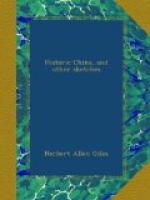TRAVEL
Books of travel are eagerly read by most classes of Chinese who have been educated up to the requisite standard, and long journeys have often been undertaken to distant parts of the Empire, not so much from a thirst for knowledge or love of a vagrant life, as from a desire to be enrolled among the numerous contributors to the deathless literature of the Middle Kingdom. Such travellers start with a full knowledge of the tastes of their public, and a firm conviction that unless they can provide sufficiently marvellous stories out of what they have seen and heard, the fame they covet is not likely to be accorded. No European reader who occupies himself with these works can fail to discover that in every single one of them invention is brought more or less into play; and that when fact is not forthcoming, the exigencies of the book are supplemented from the convenient resources of fiction. Of course this makes the accounts of Chinese travellers almost worthless, and often ridiculous; though strange to say, amongst the Chinese themselves, even to the grossest absurdities and most palpable falsehoods, there hardly attaches a breath of that suspicion which has cast a halo round the name of Bruce.
We have lately come across a book of travels, in six thin quarto volumes, written by no less a personage than the father of Ch’ung-hou. It is a very handsome work, being well printed and on good paper, besides being provided with numerous woodcuts of the scenes and scenery described in the text. The author, whose name was Lin-ch’ing, was employed in various important posts; and while rising from the position of Prefect to that of Acting Governor-General of the two Kiang, travelled about a good deal, and was somewhat justified in committing his experiences to paper. We doubt, however, if his literary efforts are likely to secure him a fraction of the notoriety which the Tientsin Massacre has conferred upon his son. He never saw the moon shining upon the water, but away he went and wrote an ode to the celestial luminary, always introducing a few pathetic lines on the hardships of travel and the miseries of exile. One chapter is devoted to the description of a curious rock called the Loom Rock. It is situated in the Luhsi district of the Chang-chou prefecture in Hunan, and is perfectly inaccessible to man, as it well might be, to judge from the drawing of it by a native artist. From a little distance, however, caves are discernible hollowed out in the cliff, and in these the eye can detect various articles used in housekeeping, such as a teapot, &c.; and amongst others a loom. On a ledge of smooth rock a boat may be seen, as it were hauled up out of the water. How these got there, and what is the secret of the place, nobody appears to know, but our author declares that he saw them with his own eyes. We have given the above particulars as to the whereabouts of the rock, in the hope that any European meditating a trip into Hunan may take the trouble to make some inquiries about this wonderful sight. The late Mr Margary must have passed close to it in his boat, probably without being aware of its existence—if indeed it does exist at all.




